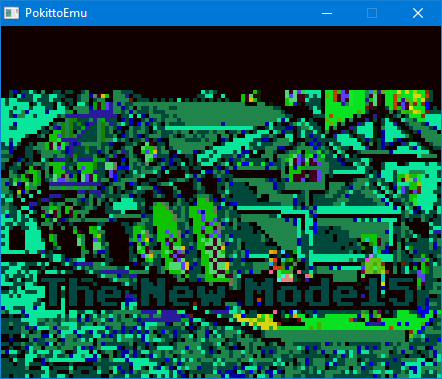It is only a couple of code lines, so you can do it easily.
I think it’s done by not clearing the screen buffer,
and instead ‘weakening’ the screen buffer before drawing.
I.e. having a palette full of different shades of a specific colour and then decrementing every non-zero palette index in the screen buffer before drawing new ones.
I can only assume though, because there’s no source code, just a .bin file:
I’ve removed the non-working modes and I am going to clean them out eventually. These are the modes that should actually be used.
Does removing the [Draft] part in the title of the wikis mean that they’re now official or just that it’s no longer the policy to put [Draft] in the title and that having them in the ‘wiki drafts’ category is enough?
That is very clear now!
We could really do with some statistics on the speed of some of these graphics modes.
If someone wants to stress test them and document the tests used, that would be much appreciated.
I agree. Copying from the framebuffer to the LCD is roughly the same speed (Mode64 being the fastest, iirc), but the speed of writing to each buffer should vary a lot. It would be useful to have a series of tests for specific functions like drawBitmapData, print, drawRect, etc.
has anyone used these modes?
MODE_NOBUFFER
MODE_ARDUBOY_16COLOR
MODE_HI_MONOCHROME
MODE_HI_GRAYSCALE
MODE_GAMEBOY //outside of gameboy port
MODE_UZEBOX
MODE_LAMENES
MODE_256_COLOR
MIXMODE
MODE14
MODE_TILED_1BIT
MODE_TILED_8BIT
Is anyone else having issues with hi-res modes not working?

In hardware also?
mode 15 seems to work OK on hardware, but mode 1 appears low-res on both.
Have you got some demo code?
I tried using TASMODE for a normal game as I wanted 220x176, 256 colour. The transparency did not seem to work but did when I reverted to Mode13.
Does TASMODE support transparency or am I just doing it wrong (my first assumption)?
Transparency only work with colour index 0, this is done for speed I believe.
Oh OK … thanks, I had my transparency set as 255. Will have to change my palette up a bit as zero is black and I think I will need that!
So … after a lot of trying, I cannot figure TASMODE out when using it as a simple 256colour 220x176. Things do not render correctly (things on the left hand side of the screen simply do not render at all!).
Is there a ‘standard’ 256 colour 220x176 mode?
220 * 176 = 38,720 and the Pokitto has 36KB of RAM (i.e. 36,864 bytes),
so there wouldn’t be enough bytes for a full frame buffer.
Yep … you are absolutely correct. I saw TAS mode and thought it was possible without doing the math.
TAS mode works because it’s splitting the screen up into tiles, hence it doesn’t use a full screen buffer despite using 256 colours and filling a full screen.
To use it as if it were a ‘standard’ mode you’d have to have enough repetition in your image that you could represent your image using tiles.
Depending on what you’re trying to do there might be another approach you could try. Though ultimately you’re probably either going to have to sacrifice some precision or do some direct drawing (which I suspect will have to be reasonably fast to avoid tearing).
I found that frustrating as well, so I started implementing what I call a strip-buffer 8bit mode, where the whole screen is split into X pieces (I’m currently using 11).
- Split the screen in X pieces (either vertically or horizontally)
- For each piece:
- Render your scene into an appropriate buffer, with the right clipping and appropriate offset (11 vertical slices -> x will be offset by 0, 20, 40, 60, …).
- Upload the buffer to the screen.
It’s kind of an intermediary between TAS and a full-screen buffer and it combines both sides perks and issues:
- Your buffer is 38kB / X and it’ll be allocated on the stack.
- In my case I’m using 11 strips, so I need 3520 bytes available on the stack, in addition to the regular stack reserve.
- You have to redraw things X times, with an offset each time.
- That means you cannot draw things in your update loop, but instead outside of it.
- That also means you should be careful not to have complicated calculation there, as it’ll be called X times on each update!
- In average, every drawing primitive (tile, sprites, lines, …) is faster than in TAS (especially the vertical-inclined ones).
- Of course, they’re also slower than full-screen buffer!
- Because it’s like printing on X screens, things are going to get clipped X times.
- Non-H/V lines (and probably polygons when I get to that point) need special consideration - otherwise they won’t join properly. We don’t get to see that in a fullscreen buffer.
- Whole screen effects (like a blurring one) will look weird on each edges if you’re not careful.
- While it requires some stack, it doesn’t need a drawing list to maintain.
- My own system is simply asking each visible entity to redraw itself X times.
In any case, it’s more complex than both Screen Buffer and TAS. I’m using it because it’s definitely worth it in my case (3D iso stuff having a lot of vertical/slanted things, …), but there is a high mental cost whenever I need to render stuff. Grouping things together for example is welcomed (e.g. your character needs 5 sprites, you’re asking yourself “is at least part of the character visible on this specific part of the screen?”)
Funnily enough, I can easily make a split-screen game with this but I haven’t found yet an application to that 